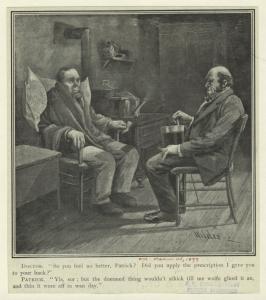by Harvey Max Chochinov
A senior colleague recently shared with me the trials of going through a bout of cancer treatment. Physicians are not known to make the best patients and the transition he described was not an easy one. At one point he said, “I wanted to hang a sign over my bed saying ‘P.I.P.’ — Previously Important Person.” To be frank, I was astounded. This man is not only a highly respected and seasoned clinician, but an internationally lauded researcher and medical leader, whose accomplishments have garnered various recognitions and lofty acclaim. And yet, being a patient, in spite of what he described as excellent care, quickly led to feeling that “who he was” was largely overshadowed by “what he had.”
The word patient comes from the Latin patientem, meaning someone who is sick or suffering. The word patience — to bear or endure without complaint — shares the identical Latin etymology. Perhaps this common derivation suggests that it takes patience to be a patient. But what is it that patients must bear and endure without complaint? Think of even your most trivial recent health care encounter. Having your call put on hold; being kept waiting for an appointment; having to disrobe or expose private information; any of these might lead you to bemoan that you felt “just like a patient” — without a doubt, the most common critique of any health-care encounter. Feeling “like a patient” means feeling defined based on a problem or diagnosis. Personhood thrives on the expression of individual identity and being able to exercise freedom and choice. Patienthood is based on diagnostic specificity; it demands adherence to certain clinical or institutional conformities and routines, in return for which it provides organ or disease specific, evidence-based options.
A woman I helped look after many years ago with leukemia was admitted for treatment to our city hospital. Being young and fiercely independent, she struggled, not merely with having to face a life threatening illness, but the sudden assault on her sense of who she was. Almost overnight, she had to relinquish her freedom and submit to strict infection controls, including isolation on the bone marrow transplant unit. Like any patient, she was assigned a chart number, given a standard plastic wrist identification bracelet, and issued the usual, drab hospital garb. Her treatment, tailored according to detailed laboratory findings and genetic markers, was highly aggressive and invasive. One morning after having encountered her share of hardships, including total hair loss, nausea and various nasty complications, she emerged from her room wearing a beautiful, full-length blue satin nightgown. Those of us who worked closely with her realized immediately that this was no frivolous gesture. In fact, this was a way of asserting herself, a way of saying: “This is who I am,” “I am more than my white counts,” “Please, see me.”
Similarly, Jean Dominique Bauby, the former editor of Elle



